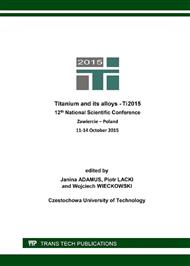[1]
M. Nałęcz, Biocybernetics and Biomedical Engineering 2000, t. 4. Biomaterials, Academic Publishing House EXIT, Warsaw, (2003).
Google Scholar
[2]
R. Pokrowiecki, B. Szaraniec, J. Chłopek, M. Zaleska, Recent trends in surface modification of the titanium biomaterials used for endoosseus dental implants, Eng. Biomat. 124 (2014) 2-10.
Google Scholar
[3]
I. C Brie, O. Soritau, N. Dirzu, C. Berce, A. Vulpoi, C. Popa, M. Todea, S. Simon, M. Perde-Schrepler, P. Virag, O. Barbos, G. Chereches, P. Berce, V. Cernea, Comparative in vitro study regarding the biocompatibility of titanium-base composites infiltrated with hydroxyapatite or silicatitanate, J. Biol. Eng. 8 (2014).
DOI: 10.1186/1754-1611-8-14
Google Scholar
[4]
D. Shen, M. Li, W. Gu, Y. Wang, G. Xing, B. Yu, G. Cao, Nash P., A novel method of preparation of metal ceramic coatings, J. Mater. Process. Tech. 209 (2009) 2676-2680.
DOI: 10.1016/j.jmatprotec.2008.06.017
Google Scholar
[5]
M. Guglielmi, Sol-gel coatings on metals, J. Sol-Gel Sci. Techn. 8 (1997) 443-449.
DOI: 10.1007/bf02436880
Google Scholar
[6]
A. Balamurugan, S. Kannan, S. Rajeswari, Structural and electrochemical behaviour of sol-gel zirconia films on 316L stainless-steel in simulated body fluid environment, Mater. Lett. 57 (2003) 4202-4205.
DOI: 10.1016/s0167-577x(03)00290-8
Google Scholar
[7]
B. Surowska, Metallic biomaterials and metal-ceramics composites for dental applications, The University Publisher, Lublin, (2009).
Google Scholar
[8]
S.M. Rabiee, Effect of zirconia concentration on the growth of nanowires in bioactive glass–ceramic coatings, Intern. J. Applied Ceramic Techn. 10 (2013) 33-39.
DOI: 10.1111/j.1744-7402.2012.02844.x
Google Scholar
[9]
Wen CE, Xu W, Hu WY, Hodgson PD., Hydroxyapatite/titania sol-gel coatings on titanium-zirconium alloy for biomedical applications, Acta Biomater. 06 (2007) 403-410.
DOI: 10.1016/j.actbio.2006.10.004
Google Scholar
[10]
P. Ducheyne, W. Van Raemdonck, J.C. Heughebaert, M. Heughebaert, Structural analysis of hydroxyapatite coatings on titanium, Biomaterials 7 (1986) 97-103.
DOI: 10.1016/0142-9612(86)90063-3
Google Scholar
[11]
M. Uchida, H. -M Kim, T. Kokubo, F. Miyaji, T. Nakamura, Bonelike apatite formation induced on zirconia gel in a simulated body fluid and its modified solutions, J. Am. Ceram. Soc. 84 (2001) 2041-(2044).
DOI: 10.1111/j.1151-2916.2001.tb00955.x
Google Scholar
[12]
M. Javidi, S. Javadpour, M.E. Bahrololoom, Electrophoretic deposition of natural hydroxyapatite on medical grade 316L stainless steel, Mater. Sci. Eng. C 28 (2008) 1509-1515.
DOI: 10.1016/j.msec.2008.04.003
Google Scholar
[13]
N. Petkova, S. Dlugocz, S. Gutzov, Preparation and optical properties of transparent zirconia sol–gel materials, J. Non-Cryst. Solids 357 (2011) 1547-1551.
DOI: 10.1016/j.jnoncrysol.2010.12.012
Google Scholar
[14]
T Kokubo, Novel bioactive materials derived from glasses, Proceedings of the XVI International Congress on Glass, Madrid (1992) 119.
Google Scholar
[15]
M. Uchida, H. -M. Kim, T. Kokubo, F. Miyaji, T. Nakamura, Bonelike apatite formation induced on zirconia gel in a simulated body fluid and its modified solutions. J. Am. Ceram. Soc. 84 (2001) 2041-(2044).
DOI: 10.1111/j.1151-2916.2001.tb00955.x
Google Scholar
[16]
M. Uchida, H. -M. Kim, T. Kokubo, F. Miyaji, T. Nakamura, Structural dependence of apatie formation on zirconia gels in a simulated body fluid, J. Ceram. Soc. Jpn. 110 (2002) 710-715.
DOI: 10.2109/jcersj.110.710
Google Scholar


